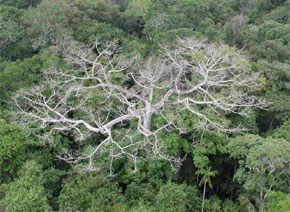

Brazil Earth System Model (BESM) is considered fundamental for climate studies (photo: NASA)
Brazil Earth System Model (BESM) is considered fundamental for climate studies.
Brazil Earth System Model (BESM) is considered fundamental for climate studies.

Brazil Earth System Model (BESM) is considered fundamental for climate studies (photo: NASA)
By Noêmia Lopes
Agência FAPESP – The deforestation and burning of the Amazon and interactions between the Atlantic Ocean and the atmosphere are some of the Brazil-specific climate issues that the Brazil Earth System Model (BESM) takes into consideration to address climate change better than the world’s existing models.
The model was presented in detail on September 9 at the opening of the First National Global Conference on Climate Change in São Paulo.
Determining how much the climate has changed, how much its characteristics will change in the future, and where this will occur is the basis for planning public policy to adapt to the impacts of global climate change, stated Paulo Nobre, general coordinator of BESM and the Brazilian Network on Climate Change (Rede Clima), at the opening of the event.
“BESM is the structural axis of climate change research in Brazil, and it supports the FAPESP Research Program on Global Climate Change (PFPMCG), Rede Clima and the National Institute of Science and Technology for Climate Change (INCT-MC),” said Nobre.
With the aim of contributing to the forecast of the consequences of global warming and the subsequent increase in the frequency of extreme events, BESM runs on the Tupã supercomputer of the Rede Clima/PFPMCG, gathering atmospheric, oceanic, surface and (soon) chemical flow data. Acquired by the Ministry of Science, Technology and Innovation (MCTI) with FAPESP’s support, Tupã is installed at the Cachoeira Paulista unit of the National Institute for Space Research (INPE).
Although not yet in its complete and final version, the model has already reconstructed the occurrence of the last El Niño currents and has estimated the return of this phenomenon, explaining the rain at the South Atlantic Convergence Zone and even estimating global ice variation in a satisfactory manner.
“The most current scenarios are available on the supercomputer, and we are taking measures so that it will be accessible to the general public by the end of the year,” affirmed Nobre.
Thirty researchers are directly involved in the development of BESM, and another 40 are indirectly connected. According to Nobre, this number should double in five years and double again in 10 years. “For this to occur, more young PhDs must take on the challenge.”
Nobre underscores the grave consequences that increases in the number of extreme climate events – such as drought, floods and tornados – have on the lives of people: “Our cities and our rural areas were not designed to deal with this new climate, which makes it essential that Brazil be part of modeling climate change,” he stated.
The four components
Iracema Cavalcanti, researcher at INPE, presented the results obtained from BESM’s atmospheric component on the first day of the conference.
In comparison to observed data, the model can generate good simulations of, for example, seasonal variability (climatological seasons), humidity flow, interannual variability (the difference between anomalies of pressure) and variability in precipitation. “There are still deficiencies, as with the majority of global models, but the general characteristics are satisfactory,” said Cavalcanti.
In relation to oceans, it is not possible to separate them from the atmospheric model, which explains why the couple modeling is strategic for the efficient functioning of the BESM, according to Leo Siqueira, also of INPE, who presented the challenges of this component.
“We have obtained good representations, but we want to improve the simulations of ocean temperature, mainly in the tropical areas and marine ice. We also want to create a healthy discussion about which model of terrestrial ice will be adopted for BESM,” said Siqueira.
Marcos Heil Costa, of Universidade Federal de Viçosa (UFV), presented the model of the third component, surface. “The main function of a model that integrates superficial processes is to supply energy flows and water vapor between vegetation and the atmosphere. This is basic. However, improvements to the system in the last few years have allowed for the incorporation of other processes,” he commented.
Some of these processes include the following: radiation, energy and matter flows; the Earth’s carbon and nitrogen cycles; recovery of abandoned areas; fires in natural vegetation; agricultural crops; seasonal flooding and flows; land usage by humans (deforestation); the specific representation of ecosystems; and soil fertility.
Chemistry is the fourth and most recent component. “Without a chemistry model, the others have to be constantly adjusted,” said Sérgio Correa, researcher at Universidade Estadual do Rio de Janeiro (UERJ). Correa leads the studies on atmospheric chemistry, which will allow scientists to refine the BESM data when this component is added to the model in one of the next stages.
Collaborations with researchers at foreign institutions and trainings are other strategies that are in place to improve the representations of Brazil and South America, both domestically and abroad.
More information on the First National Conference of Global Climate Change is available at www.fapesp.br/conclima.
Republish
The Agency FAPESP licenses news via Creative Commons (CC-BY-NC-ND) so that they can be republished free of charge and in a simple way by other digital or printed vehicles. Agência FAPESP must be credited as the source of the content being republished and the name of the reporter (if any) must be attributed. Using the HMTL button below allows compliance with these rules, detailed in Digital Republishing Policy FAPESP.




